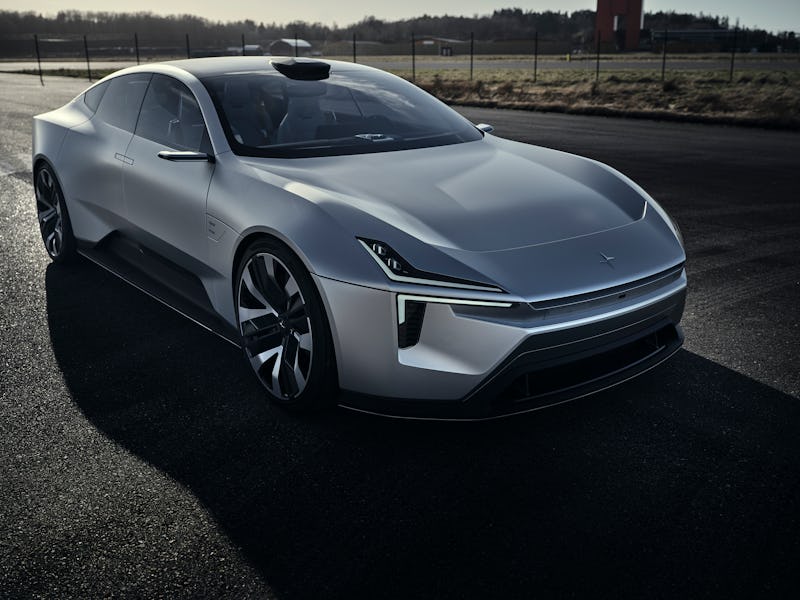What the Polestar Precept tells us about the firm’s next electric car
The company's new electric vehicle marks a shift for the firm.

The Precept is Polestar's most elusive vehicle, yet also its most significant.
The concept electric car was scheduled to make its debut at the Geneva Motor Show in Switzerland, scheduled for 5 to 15 March. With the coronavirus pandemic, both the show and the Precept's debut was canceled. But while Polestar doesn't intend to actually sell the Precept to consumers, on Tuesday it made up for the missed unveiling by releasing a YouTube video that shows the car in action.
Although it's an unexpectedly quiet debut, there's nothing quiet about the Precept's message. It follows Polestar's first two cars, the aptly-titled Polestar 1 hybrid sports car from 2019 and this year's all-electric Polestar 2 designed to compete with the Tesla Model 3. The brand is still closely associated with the Volvo Car Group, Polestar design director Max Missoni tells Inverse, but the team felt it was time to flesh out its own vision for the future.
"There was a need to show our vision for the future," Missoni says. "So the Precept as a manifesto of our design language, of our ideas, of our future technologies, was the perfect thing to do for this point in time."
The car, Missoni explains, will act as a "bridge" to Polestar 3 and future cars. The Polestar 3 will be a premium performance sport utility vehicle, entering production "within the next few years."
Watch the company's reveal video below:
The Precept's design is built around its all-electric approach. The Smart Zone, for example, runs across the front of the vehicle and offers a number of sensors. It's situated where a traditional car used to take in air to keep the engine cool, and Missoni refers to the transition as "from breathing to seeing." The interior is also reshaped due to the larger amount of space offered by removing the engine. Aerodynamics have also played a more central role, as an electric car needs to move through the air swiftly to travel more miles per charge – but for the Precept, Polestar is not discussing drag coefficient or range.
The car also features a greater focus on new technologies. The car has no rearview mirror, instead using a rear camera to offer the same view, leading to more headroom. It also uses cameras for the side mirrors: while using cameras to replace the rear mirror is legal, this latter change will have to remain in the concept phase for now due to legal restrictions.
Beyond the Smart Zone, the car also features lidar sensors at the top of the windshield. Missoni says the car features "advanced pilot assist," but did not reveal which SAE level the car would reach.
At a smaller level, the car has a number of tags that explain its makeup. The Smart Zone has small tags explaining each sensor and showing the heat elements. The interior's "3D Knit" surfaces highlight that it's made from 100 percent recycled polyester.
"It's like in music," Missoni says. "A good piece of music only works if you have a strong theme, a strong melody...that you can remember, but it's extremely pure and stays with you. But then when you listen to it again, and again, you discover layers and layers, to the point where it's only sound in the background, but it really enriches your experience. And that's the same with design."
These tags highlight the use of recycled and lightweight materials in the interior: the exterior panels use a material based on flax linen, measuring 50 percent lighter than normal plastic panels and with 80 percent less plastic content.
"We didn't want to use the traditional tools," Missoni says. "Wood and leather and these things...we wanted to set ourselves the challenge to create a new, premium authentic, a new luxury aesthetic based on these materials."
All this is part of Polestar's aim to use technology to offer simplicity even as systems grow more complex. Eye-tracking understands where a user's eyes are, so if they're not looking at the instrument cluster, for example, the system can increase the size of elements to make them easier to see.
This is also seen with the 15-inch touchscreen, which uses a Google-powered infotainment system. This detects when a finger is approaching the screen and laters the on-screen elements to make them easier to touch.
"When technology is applied the right way, you simplify people's lives using more complex technology," Missoni says.
Although the Precept looks set to remain a concept, it's a key milestone in showing how Polestar is thinking about what the future of cars could look like without many of the traditional constraints.